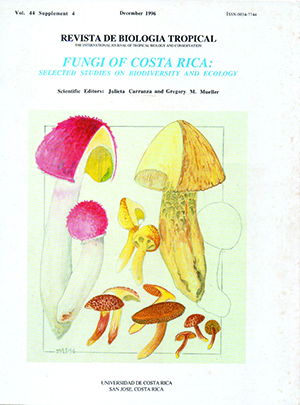Abstract
Two hundred and thirty-one species of pore fungi within 72 genera have been reported from Costa Rica. Based on Herrera and Gómez's 1993 Biotic Unit Map, the majority of the pore fungi are present in the Tropical-Tropical Unit (51 genera, 100 spp.), followed by Temperate-Tropical (46 gen. 85 spp.), Subtropical-Tropical (40 gen. 83 spp.) and Temperate-Cold (15 gen. 19 spp.). Only three genera are known from the Boreal-Tropical Unit. Many of these genera are cosmopolitan (45.8%), followed by 33.4% tropical and 20.8% boreal. Sixty-four cause white rot on hardwood trees and eight cause brown rot on hardwood and softwood trees. Amauroderma appears to be the gently genus restricted to a specific unit (Tropical-Tropical) and Fistulina and Bondarzewia to have a narrow host range (Quercus sp. and Alnus.).
References
Carranza, J. 1982. Polypores New to Costa Rica. Mycotaxon 15: 405-408.
Carranza, J. & J.A. Saenz. !984. Wood decay fungi of Costa Rica. Mycotaxon 29: 151-166.
Carranza-Morse, J. 1991. _Pore fungi of Costa Rica. I. Mycotaxon 41: 345-370.
Carranza-Morse, J. 1992. Pore fungi of Costa Rica. II. Mycotaxon 43: 351-369.
Carranza-Morse, J. 1993. Pore fungi of Costa Rica. III. Mycotaxon 48: 45-57.
Covington, D.J. 1980. Fungi Costaricensis. A checklist of reported species. Master Thesis, Tulane University, Louisiana.
Gilbertson, R.L. & L. Ryvarden. 1986. North American Polypores. Vol. I Fungiflora, Oslo, Norway. 433p.
Gilbertson, R.L. & L. Ryvarden. 1987. North American Polypores. Vol. 2. Fungiflora, Oslo, Norw(ly. 452p.
Gómez, L.D. 1986. Vegetación de Costa Rica. In L.D. Gómez (ed.). Vegetación y Clima de Costa Rica. Vol. 1. Editorial Universidad Estatal a Distancia, San José, Costa Rica. 280 p.
Gómez, L.D. & L. Ryvarden. 1985. lnonotus fimbriatus nov. sp. (Hymenochaetaceae, Basidiomycetes}. Mycotaxon 23: 291-292.
Herrera, W. 1985. Clima de Costa Rica .. In L. D. Gomez (ed.). Vegetación y Clima de Costa Rica. Vol. 2. Universidad Estatal a Distancia. San José, Costa Rica. 280 p.
Herrera, W. & L.D. Gómez. 1993. Mapa de Unidades Bióticas de Costa Rica. I: 685000. San José, Costa Rica.
Holdridge, L.R. 1967. Life Zone Ecology. Tropical Science Center, San José, Costa Rica. 206p.
Larsen, M. J. & L. A. Cobb Poulle. 1990. Phellinus. (Hymenochaetaceae). A Survey of the World Taxa. Synopsis Fung. 3: 1-206.
Lowe, J. L. 1963. A synopsis of Poria and similar fungi from the tropical regions of the world. Mycologia 55: 453-486.
Lowe, J. L. 1966. Polyporaceae of North America. The Genus Poria. State University of New York. College of Forestry, Syracuse, N.Y. Techn. Pub. 90. 183p.
Lowe, J. L. 1976. On Polyporus sobrius. Kew Bulletin 31: 753-754.
Murrill, W. A. 1915. Tropical Polypores. (privately printed). New York. 113p.
Nuñez, M.P. 1994. First records of Henningsia brasiliensis outside Brazil. Mycologist 8: 175- 176.
Ruiz, A. 1996. Amauroderma pseudoboletum (Aphyllophorales: Ganodermataceae) nuevo registro para Costa Rica. Rev. Biol. Trop. 44 Sup!. 4: 149.
Ryvarden, L. 1991. Genera of Polypores, nomenclature and taxonomy. Fungiflora. Oslo, Norway. 363p.
Ryvarden, L. & I. Johansen. 1980. A Preliminary Polypore Flora of East Africa Fungiflora, Oslo, Norway. 636p.
Sydow, H. 1925. Fungi in itinere costaricensi collecti. Pars prima. Ann. Mycologici 23: 308- 429.
Tosi, J. 1969. Mapa Ecológico de Costa Rica 1: 750000. Centro Científico TropicaL San José, Costa Rica.
##plugins.facebook.comentarios##

This work is licensed under a Creative Commons Attribution 4.0 International License.


